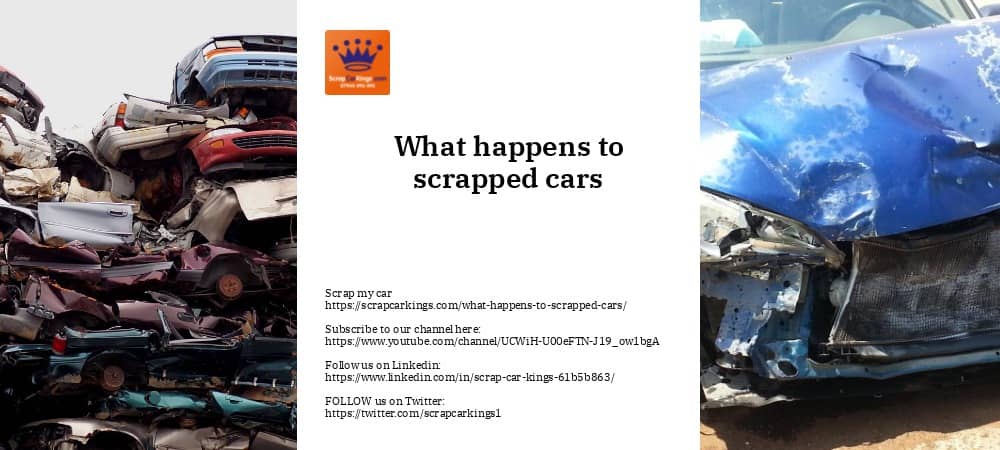What happens to scrapped cars

Quick summary of what happens to scrapped cars
- A car is taken to an Authorised Treatment Facility (ATF) so it can be recycled properly
- All reusable car parts are removed
- The AFT will then remove all hazardous materials
- The car battery should be removed and recycled
- The car is then crushed and all of the materials are separated and recycled or sent to landfill
When a car reaches the end of its useful life, it still has value as a source of spare parts. This has created a vehicle recycling industry, which is sometimes referred to as a wrecking yard, scrap yard, car spare parts supplier, or recycling automobiles. In recent years, manufacturers have become involved in the vehicle recycling process. A car crusher is often used to reduce the size of the scrapped vehicle for transportation to a steel mill. Car recycling has many benefits, including reducing pollution, conserving resources, and saving energy.
Every year, millions of vehicles reach the end of their useful life and are scrapped. Although these scrap cars are no longer functional, they can still be used to provide valuable resources such as metal and other recyclable materials. The vehicles are shredded and the metal content is separated for recycling. In many cases, the remaining debris is further sorted by machine in order to recover additional materials such as glass and plastics. The remainder of the scrap car, known as automotive shredder residue (ASR), is typically sent to a landfill.
ASR contains a variety of recyclable materials, including polymers and residual metals. However, due to the complex nature of ASR, it is often difficult to recycle. As a result, a large portion of ASR ends up in landfills each year. However, with advances in recycling technology, it may be possible to recover more of the valuable resources contained in ASR in the future.
How to scrap your car
Below is a quick summary of how to scrap your car
- Look online for a scrap car companies
- Get a few quotes so you can find the best one
- Accept the best quote & arrange a free scrap car collection
- Provide the scrap car dealer with id. see what kind of photo ID you need to scrap a car
- Get a receipt from the scrap car dealer
- Give them the V5 registration document retaining section 9. Complete section 9 of the V5C document (or section 4 on V5Cs issued after April 2019) and send it to the DVLA
- Contact your insurance company who will cancel the policy and provide you with a refund for any months of unused insurance
- You will receive a certificate of destruction within 7 days
How does car recycling happen?
In the past, car owners would simply send their vehicles to the scrap yard once they were no longer functional. However, this process was not only harmful to the environment, but it also resulted in the car sitting in a landfill for years before it was finally crushed into small cubes. Thanks to the scrap metal dealers act, car owners are now required to take their vehicles to an Authorised Treatment Facility (ATF) to recycle vehicles properly. There are over 2,000 ATFs located throughout the United Kingdom, and each one has been approved by the government’s Environment Agency. These facilities have concrete surfaces and sealed drainage systems to prevent any toxic fluids from leaking into nearby water sources. Not only is this process better for the environment, but it also ensures that your car will be properly recycled and reused.
Reuse of car parts
Harvesting reusable parts such as air bags or a catalytic converter from end-of-life vehicles is an important first step in the scrappage process. By reusing components that are still fit for use, we can help to reduce the consumption of energy and materials. Parts that are harvested from end-of-life vehicles are either used as spares or refurbished and sold on to keep other cars on the road. This helps to extend the life of existing vehicles and reduces the need for new vehicles to be manufactured. In addition, harvesting parts from end-of-life vehicles helps to create employment opportunities in the automotive industry. Therefore, it is clear that there are many benefits to harvesting reusable parts from end-of-life vehicles.
The depollution process
The process of depolluting a vehicle starts with the removal of hazardous materials. This includes things like batteries, which can release acid and lead if they’re ingested, and fuel tanks, which can contain explosive materials. Next, airbags are taken out. These often contain chemicals that can be harmful to humans, so it’s important to take precautions when handling them. Finally, seat belt pretensioners are eliminated. These devices usually contain flammable materials, so they pose a safety risk if they’re not properly disposed of. By following these steps, you can ensure that your vehicle is as safe as possible for both you and the environment.
Can electric car batteries be recycled?
Can electric car batteries be recycled? The simple answer is yes, however, the process is not without its challenges. Recycling a car battery means that many companies will only do so if it works out financially beneficial. The battery cells themselves are more difficult to recycle as they contain hazardous material that can pollute the environment. A simple solution to this is the reuse of old EV batteries with less capacity for other second-life applications. Volvo has been exploring the use of depleted Electric vehicles battery packs as solar power storage systems and in other applications, proving the lifespan of these batteries extends beyond that of a typical vehicle. While recycling electric car batteries is not without its challenges, it is possible and there are many benefits to doing so.
Crushing your scrap car
Once a car has been determined to be scrap, there are a few steps that need to be taken in order to properly recycle it. First, the scrapped car is made safe and a Certificate of destruction is raised. Next, it is added to the scrap heap and broken up into small pieces using rotary hammers. The smaller pieces are then conveyed under magnets, which pull off the steel. Around 70 per cent of a car’s weight is steel, so this process retrieves around 10 tonnes a year. The remaining materials are then vacuumed up and recycled accordingly. This process helps to reduce environmental waste and ensure that valuable materials are properly reused.
End of Life Vehicle Directive
The End of Life Vehicles Directive was introduced by the European Union in the mid-1990s in order to reduce the amount of dead vehicles being sent to landfill every year. The directive put the responsibility for end-of-life vehicles back in the hands of the manufacturer, and required car makers to design vehicles that were easier to recycle and reuse. As a result of the directive, car manufacturers can no longer use certain toxic materials in their vehicles, and must take them to an authorised dismantling facility when they reach the end of their life. The End of Life Vehicle Directive has resulted in a significant reduction in the amount of waste sent to landfill, and has helped to make Europe’s car industry more sustainable.
Get a certificate of destruction
When you scrap your car, it’s important to make sure you get a Certificate of Destruction (CoD). This document proves that your car has been dismantled and will never be driven on the road again. Without a CoD, you could still be liable for tax and penalties if the vehicle is involved in a traffic offence.
Getting a CoD is easy – just take your car to an authorised treatment facility (ATF) and they’ll take care of everything. An ATF must tell you if it decides it can repair and resell your vehicle, but if you want to scrap it, they’ll issue you with a CoD. Once you have the CoD, the ATF will pay you for your car via bank transfer – they’re not allowed to pay you in cash as part of an effort to reduce car crime.
So if you’re scrapping your car, make sure you get a CoD to avoid any problems down the line.


